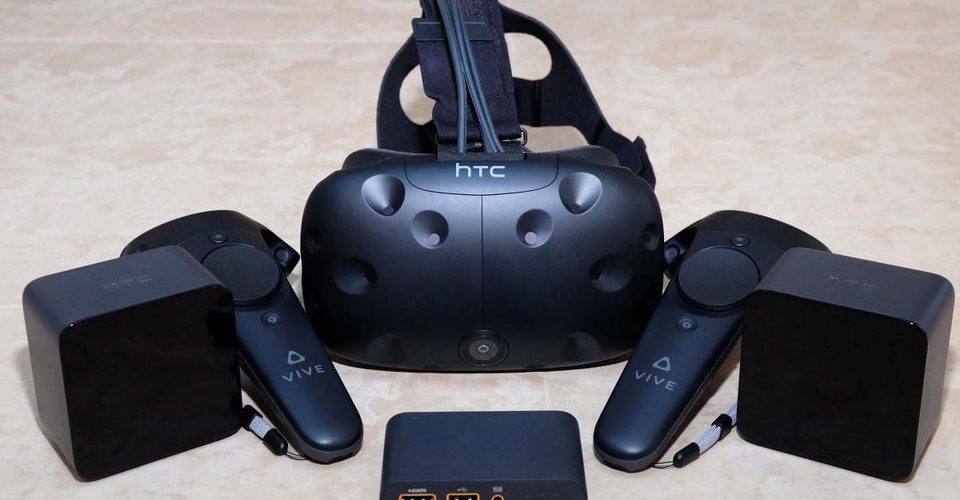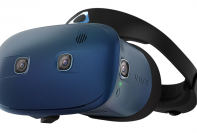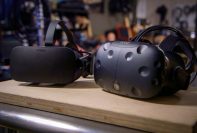HTC and Oculus are the only two companies that come to mind when someone talks about virtual reality headsets.
Both of these companies entered the market when there was no competition and both of them are engaged in a battle for a larger market share.
HTC has the HTC Vive and Vive Pro in its lineup, while Oculus has done a much messier job by launching VR headsets for multiple different markets.
Oculus has mobile VR headsets, standalone VR headsets and high-end PC-tethered VR headsets in its lineup.
Between all this competition, newcomers are often very confused about which product should they choose for their own VR journey.
Of course, Oculus wants you to buy their products, while HTC will be fighting tooth and nail to make sure that you choose the Vive or the Vive Pro.
The next best option for these newcomers is to ask for help from the community.
Sadly, the VR community itself isn’t strong enough or large enough to provide suitable help.
If you are stuck, we would highly recommend that you don’t take a leap of faith.
There are ways to help you make your decision.
We regularly post reviews of the latest and greatest products in the AR VR industry, so that people who don’t have a lot of technical knowledge can wisely decide if they need a product or not.
As the title suggests, this review’s topic is the HTC Vive.
Of course, the HTC Vive Pro is much better and complete than the original Vive.
However, there still are reasons that make the Vive a better option than the Vive Pro in some cases.
For instance, the HTC Vive Pro has a very poor price-value ratio, which makes it an unnecessary purchase for entry-level VR enthusiasts with a limited interest in VR gaming.
In this review, we will discuss the advantages and disadvantages of the HTC Vive and compare it to its competitors and its own big brother, the HTC Vive Pro.
By the end of this review, you will have a clear idea of whether you should buy the HTC Vive.
Perhaps the most important thing that a beginner needs to know about the HTC Vive, is that the HTC Vive is a PC-tethered VR headset.
You will have to also consider buying a high-end gaming rig, in order to run the HTV Vive.
This changes the whole dynamics of your decision since you also have to worry about investing in a gaming rig, the configuration of that gaming rig and other similar issues.
Release Date and Price
The HTC Vive was released on April 5, 2016, with a price of $824.
Since Oculus was very aggressively reducing its prices, HTC was forced to keep the HTC Vive within a reasonable margin and dropped the price to $800 a month later.
Since then, the HTC Vive has lost almost $300from its price and is now available from the official website for $499.
Although the HTC Vive is being sold for a very cheap price, compared to the Vive Pro or the upcoming Vive Focus, it’s also very outdated.
You will probably not be able to play the latest VR games, especially those with the most visually pleasing graphics settings.
People often overlook the gaming computer that they will need, in order to run the HTC Vive.
HTC recommends the following computer configuration for the HTC Vive:
- Intel Core i5-4590 or AMD FX8350 or better CPU
- NVIDIA GeForce GTX 1060 or AMD Radeon RX 480 or better GPU
- 5 GB or more RAM
- HDMI 1.4 or DisplayPort 1.2 or newer display connector
While this system requirement is slightly cheaper than the pc configuration required by the HTC Vive Pro, it is still quite expensive.
A gaming computer with these specifications would cost between $800-1,000.
Therefore, if you don’t have a gaming PC, the total cost will be $1,300-1,500.
If you already have a gaming computer but one or two components are not powerful enough, you can easily upgrade them at a much lower cost.
Is the HTC Vive worth this investment? Let’s find out!
Design
Before choosing a VR headset, you must consider its design.
When talking about VR headsets, the design isn’t considered only for its looks.
How a VR headset’s ergonomics are set, will define how easily it can be used, how long can you use it before getting irritated, how heavy it feels on your forehead, how much it irritates your skin and many other factors.
Soft and Comfortable Material
The most important thing at first is the material used inside the headset.
The HTC Vive features a very soft and comfortable material with a covering across its borders by a soft material that resembles memory foam.
The memory foam covering ensures that there are no cracks left open from where the light from the outside might enter.
During our tests, we also found that the foam helps to reduce skin irritation.
This makes the VR headset very comfortable to wear, even for long gaming sessions.
Having a nice and comfortable feel inside the VR headset is one of the most important things to a VR gamer since the immersion can be ruined by irritation and discomfort.
The material inside is fixed by the use of Velcro and can be swapped out.
Therefore, if your headset’s inside material gets dirty or is damaged, you can easily swap it out for a new one.
The packaging includes two fits: a wide one and a thin one.
You can try both on to see which one fits the best on your face and go with that one.
That is a cool feature by HTC and we highly appreciate it.
Easily-Adjustable and Comfortable Velcro Strap
The strap accompanying the VR headset also plays a key role in improving or ruining the comfort of the headset, since it is responsible for holding back the weight of the headset.
Many VR headsets are sitting heavily on the nose bridge, which causes pain within half an hour of continuous use.
The Velcro Strap featured on the HTC Vive is a completely different story.
The strap itself is made of comfortable material and doesn’t feel irritating at all on your head.
The strap does a pretty good job of holding the weight of the headset back and gives some relief to your nose bridge.
While there is no VR headset that does a perfect job of distributing the weight of the VR headset equally across the users’ head, the HTC Vive’s strap comes pretty close.
The strap is also easy to adjust since it’s tied down by Velcro.
Hardware-Based IPD Adjustment
The HTC Vive comes with a hardware implementation of the IPD adjustment system, which is fast to operate and works for a large range of focal lengths.
If you don’t understand what this, the IPD is the distance between your eye and the display.
If this distance is not set properly based on your eyesight, your display will be out of focus and a total blur.
Many headsets allow you to adjust this property using a software program.
However, that system doesn’t cover a large range and, in some cases, can feel a bit uncomfortable.
The IPD adjustment knob is located on the underside of the headset.
All you have to do is to slowly turn the knob until the display gets into perfect focus.
The IPD adjustment system in the HTC Vive is a great alternative if you don’t feel comfortable wearing spectacles while playing VR.
Ample Room for Eyeglasses
I know that we talked about the IPD adjustment in the previous section.
However, some people actually prefer using the headset with their glasses on.
If you are that kind of person, you don’t need to worry, since the HTC Vive has a lot of room inside for spectacles.
Of course, you can’t fit very large ones inside, but you can comfortably wear the headset with average-sized glasses.
Comfortable and Easy-to-Use Controllers
Two HTC Vive Controllers are included in the HTC Vive package.
The Vive Controllers are very lightweight and comfortable in the hand.
However, they are very sturdy and made of high-quality material.
The controllers include cleverly placed triggers, buttons and a circular touch panel that you can use in a variety of ways in different games.
The controllers include IMU sensors (Inertial Measurement Unit) that help in tracking the position and movement of your hand.
The Vive Controllers have an excellent tracking mechanism and work very smoothly, no matter how fast you are moving them.
No Built-In Headphones
One of the downsides of the HTC Vive VR headset is that it doesn’t come with a built-in audio output.
HTC does offer an audio strap called the Deluxe Audio Strap. However, that costs $89.
This just adds more to the already high cost of getting started on the HTC Vive.
However, people who prefer their own gaming earphones don’t have to worry about this, since they won’t need a built-in audio solution.
Wired Tethering
One of the most problematic things about the HTC Vive is that the VR headset is wired and not wireless.
While there are a few third-party wireless solutions available, they are not worth the price.
The HTC Vive’s heavy cables are a nuisance.
You can feel them dragging, whenever you move your head.
It has a negative impact on immersion.
Performance
Now that we have discussed all of the pros and cons of the HTC Vive’s design, we will discuss its performance specifications and how it compares to other VR headsets in its class.
Crisp Display Resolution and High Refresh Rate
The most important thing to consider when buying a high-end VR headset is the display resolution and its refresh rate.
This is because the display resolution plays a very important role in the crispness of the graphics to the eye.
The refresh rate, on the other hand, is responsible for making the mind believe that it is in a virtual reality, which is very similar to the actual reality.
A higher refresh rate will enhance the experiences, while a slower refresh rate could cause motion sickness and even nausea.
With the HTC Vive, you won’t have to worry about either of these factors.
The VR headset features a display resolution of 2,160 x 1,200 pixels.
When calculated for each eye, we get 1,080 x 1,200 pixels for each eye.
This resolution provides a great pixel density and makes the VR experiences look very attractive visually.
The high-res display in the HTC Vive has a refresh rate of 90Hz, which is more than enough for you to perceive well-defined animations, as well as stay immersed in the content.
As a comparison, 90Hz is the kind of refresh rate that has been fairly recently been made possible in the PC gaming sector.
The 60 Hz refresh rate was the best option you could get five years ago.
You might be thinking, why are the refresh rate and display resolution so important for VR?
About it is necessary to retain the immersion and for a proper sense of balance.
There is a certain refresh rate at which our brain perceives the reality.
We cannot match that refresh rate with today’s technology.
However, the closer we get to it, the more “normal” it gets for the brain.
Your brain can spot stuttering, glitches, screen tearing, and basic lag, if the refresh rate of the display is too low.
However, if you detect these problems on a traditional display, you won’t feel out of balance or motion sick.
This is because the effect is being observed on a very small portion of your total field of view.
With VR headsets, these effects are much more intense.
This is because the lagging is being observed all across your field of view.
Seamless Head Tracking
Since a large portion of character control is based on the movements of the actual controller, the tracking system of the VR headset plays a very important role in keeping the immersion alive.
The HTC Vive comes with one of the most accurate tracking systems available in the market right now.
Therefore, tracking is not an issue with the HTC Vive.
HTC says that the HTC Vive features over 70 different sensors that are dedicated to tracking the movements of the player.
The VR headset is capable of tracking movement with an accuracy of 1/10th of a degree.
This is a very impressive figure to achieve.
The more important question is, does it lose track?
This happens when the sensor data gets so noisy that the tracking system has no other option but to stop tracking, flush the entire memory and recalibrate before continuing tracking.
Different companies have come up with different solutions to this problem.
HTC’s solution is one of the best in the industry.
Even during hour-long gameplay sessions, we did not face any loss of tracking and our experiences were usually very seamless.
Loss of tracking is one of the biggest mood killers in VR since it works like a snap that brings you out of the immersive state and ruins “the flow”.
Seamless Room-Scale Tracking
The HTC Vive also comes with two base stations that connect to your computer.
These base stations track your position and movement inside the playing space and help the game react accordingly.
If placed properly, they can provide extremely seamless tracking and will not lose your position once, even in an hour-long VR gaming session.
These HTC base stations can track your position and movement in a space of up to 15 x 15 feet.
The HTC Vive’s tracking is absolutely phenomenal.
You will get immersed after 10-15 minutes of playing.
This is especially true for fast-paced games, where you have to make quick and sudden actions to dodge incoming hits or attack the opponent.
Your brain will be pumping adrenaline within 15 minutes of playing this game.
It won’t be cut-off at any point during your session, as long as you have set up the base stations properly.
HTC Vive Pro VR Gaming Setup
Setting up the HTC Vive for the first time is a bit of a hassle.
However, it’s not a difficult process.
HTC recommends that users download the updated setup software from the official product page.
The software gives clear and simple instructions on how to set up your hardware (controllers, base stations and cables) and installs Steam VR and Viveport on your computer.
If you don’t have Steam already installed, it will be done by the setup itself.
The most important part is setting up and calibrating the base stations.
The base stations come with a mounting mechanism that you can use to mount the sensors permanently on a wall.
However, this works as a more permanent solution.
We would not recommend this.
The base stations can be mounted on tripods and light stands, which can then be moved and adjusted easily.
The latter option will not only keep your gaming setup portable, but it will also allow you to easily move or adjust the base stations when needed.
Another reason why we don’t recommend the wall mounting option is that most of the time, your play area will be available in the middle of the room, instead of a corner.
You will have to mount the sensors in a corner of the room so that the 15 x 15 feet measurement is covered properly by both the stations.
You will then have to calibrate the base stations, by showing them the floor and mapping the play area.
The first part is done by simply placing the controllers on the floor and letting the sensors do the magic.
Once the calibration is complete, the setup software will ask you to pick up the controllers.
The next step is mapping your play area.
You can do that by simply holding the trigger of the controller and walking on the edges of the playing area that you have cleared up for VR gaming.
The controllers will be constantly vibrating to provide positive feedback during the process.
Once the process is completed, the setup software will show you the mapped area to verify that it has mapped the playing area correctly.
Once you confirm the mapping, you are ready to put on the VR headset and get started.
During your first go, a cute robot will greet you and teach you the basics of using the VR headset and the controllers.
You will learn which button does what and how you can navigate across different menus, confirm selections, go back and other functions.
At this point, you are ready to start downloading and playing VR games.
Content Library
Any VR headset’s key to survival is a large and versatile range of content that users of different tastes and interests can choose from.
The HTC Vive has two main sources of content: the Viveport and Steam VR.
Valve (owner of Steam) partnered with HTC to develop the Steam VR platform, which is why we highly recommend it.
The Steam VR library has many different VR games, as well as countless other VR experiences that will impress you with their beauty and robust storytelling.
The platform has many small VR games with playtimes of two to six hours.
You can unleash your creativity by 3D drawing VR apps like Tiltbrush.
Do you want to go to space and fight off some space pirates?
Space Pirate Trainer is there for you.
Are you ready to get one of the most colorful visual tastings?
Download the Blu and experience a whale encounter, a reef migration, or the luminous abyss in a way that you could never have experienced before.
There are also entire AAA games that are ported from PC to VR, like Fallout 4 VR for intense PC gamers who would love to play their favorite PC games in virtual reality.
Comparisons
Now that we have discussed all of the major details about the HTC Vive, let’s see how the VR headset stacks up against its competitors.
HTC Vive vs HTC Vive Pro
Before getting into any details, we will simply say that the Vive Pro is simply a better VR headset than the Vive.
One of the main features that make the Vive Pro better than the Vive, is its display resolution.
The Vive Pro features a display resolution of 2880 x 1600 (1440 x 1600 per eye) which makes it far better and crisper than the display of the HTC Vive.
Other major upgrades include dual cameras on the front for better tracking and better AR support, an even more comfortable and knob-adjusted strap which comes with superb built-in speakers, and a very slim connector to tether the headset to the PC.
This slim cable is the only one needed to connect the Vive Pro to a PC and it makes the experience much better.
While the HTC Vive Pro is much better, you also have to keep I mind that it is much more expensive than the Vive to be compared.
Therefore, if you aren’t looking for the most premium experience in VR, you can skip the Vive Pro.
HTC Vive vs Oculus Rift
The HTC Vive and the Oculus Rift more or less are direct competitors, since they are both in the same price category.
With that in mind, the first thing that the HTC Vive does better than the Rift is motion tracking.
The Vive is capable of seamless motion tracking, while the Oculus Rift is known to have some problems in tracking the player’s actions.
The same is true for room-scale VR.
The two base stations that come with the HTC Vive are pretty great.
They won’t lose track, even after an hour-long gaming session, which includes quick and sudden moves.
The Oculus Rift, however, tracks very poorly with the two sensors it comes with.
You will, therefore, have to buy another sensor separately to improve its tracking.
Both the headsets feature the same display resolution and have the same 90 Hz refresh rate.
The Oculus Rift, however, comes with built-in speakers right out of the box.
This is an advantage that it has. which is one plus in our books.
Therefore, if buying a third tracking sensor is not an issue for you, the Oculus Rift is pretty close to the HTC Vive.
Our Verdict
Now that we have discussed almost all of the details of the HTC Vive, were will summarize our findings, so that you can make a clear decision.
The HTC Vive is old. It’s not too old to be outdated.
However, it is old in that its performance is surpassed by the Oculus Vive Pro and other products that are about to hit the market.
For instance, the HTC Vive Pro is going to get a new variant which will feature built-in eye-tracking.
This eye-tracking solution will be used for foveated rendering, in which, only that part of the display is fully rendered where the eye is looking.
This will allow the graphics card to dedicate the computing power towards a smaller area and leave the rest of the display in a low-quality state.
In other words, you will be getting better graphics quality and overhead, without upgrading the graphics card.
As you can see, there is a lot going on.
The HTC Vive will probably be pushed even farther down the chain when these products are launched.
However, every new product is more expensive than the other and requires an even more hardcore gaming computer to run.
Not everyone is a hardcore enthusiast, who are looking for the best of the best products in the market without any regard for the price-value ratio.
The HTC Vive has a very strong and large content library, which will keep you are busy with new and unique VR experiences for at least a full year.
Don’t forget that this library is not static, it is rapidly growing with more and more VR games and cool VR apps being added to it.
This VR headset is a great entry-level VR headset for many people who are looking to get into virtual reality.
If you care about price-value ratios and want to get a reasonable VR headset to get started, the HTC Vive would work perfectly for you.
It is a cheaper alternative to the HTC Vive Pro, it works better than the Oculus Rift in many aspects and it doesn’t require a very high-end gaming computer to run, unlike the HTC Vive Pro or the Oculus Rift S.
However, if you are a person who doesn’t care about money and only wants the best that money can buy, the HTC Vive is not the best choice.
You would be better off with an HTC Vive Pro, the Oculus Rift S, or the Vive Pro variant with built-in eye-tracking that we discussed.




